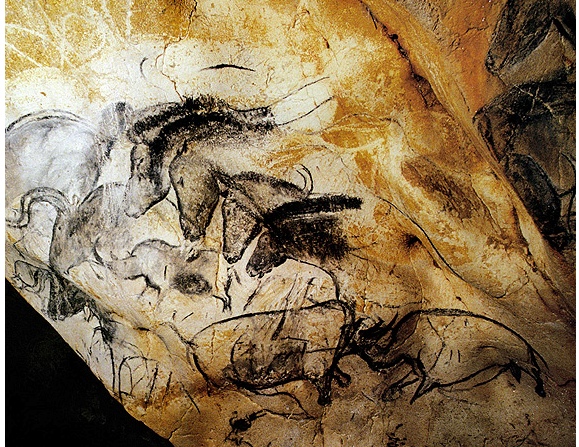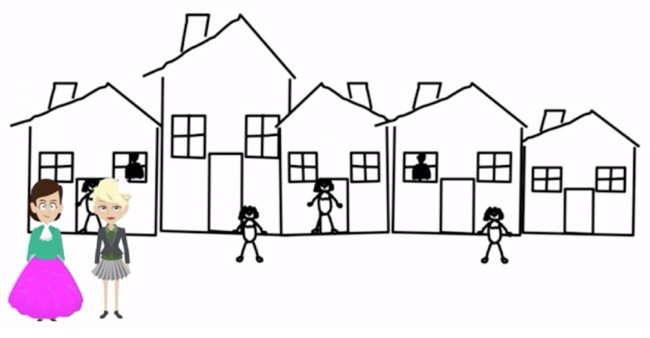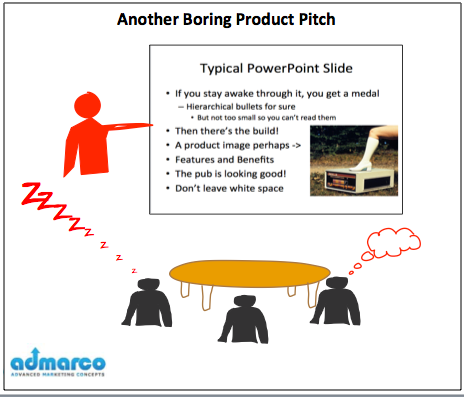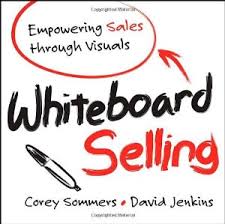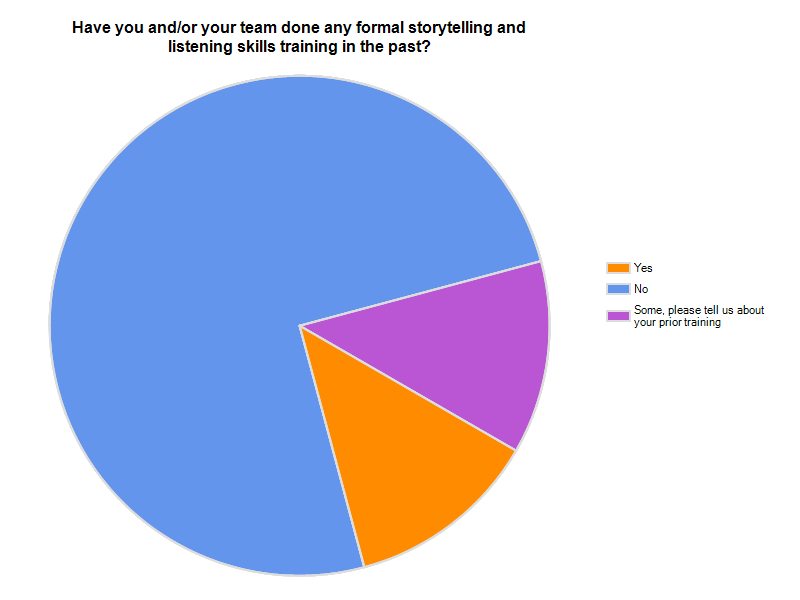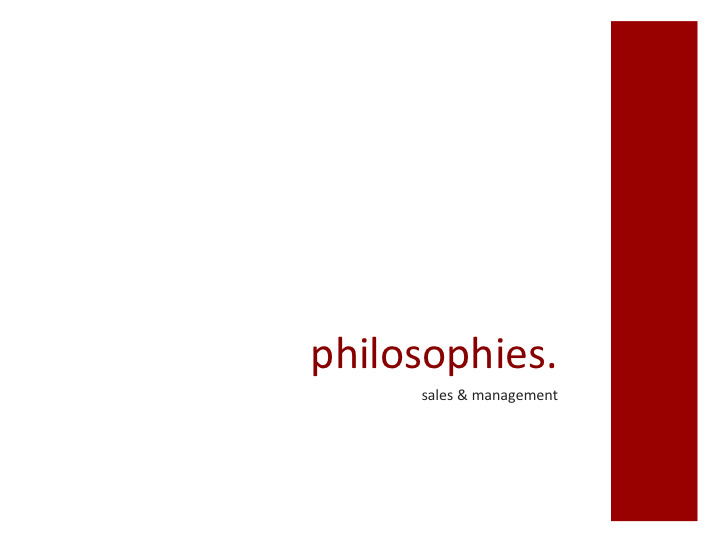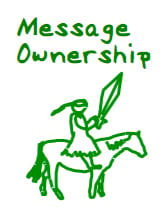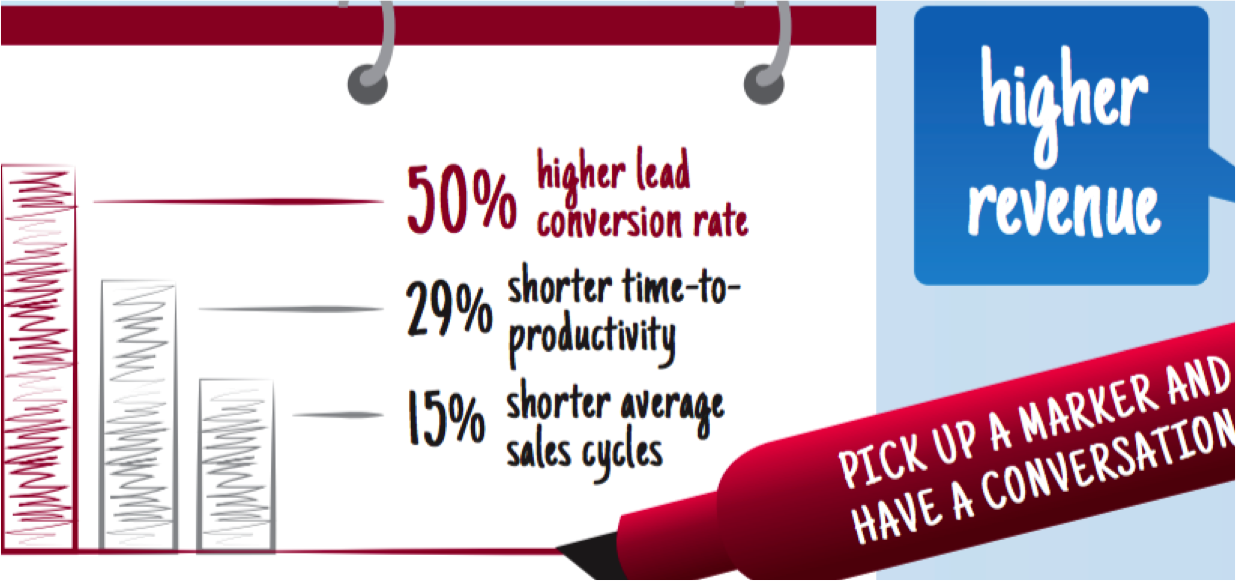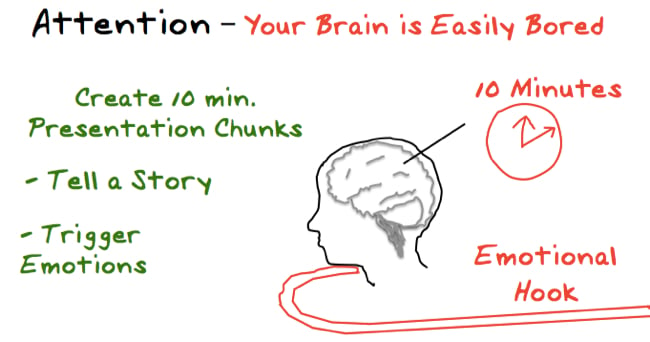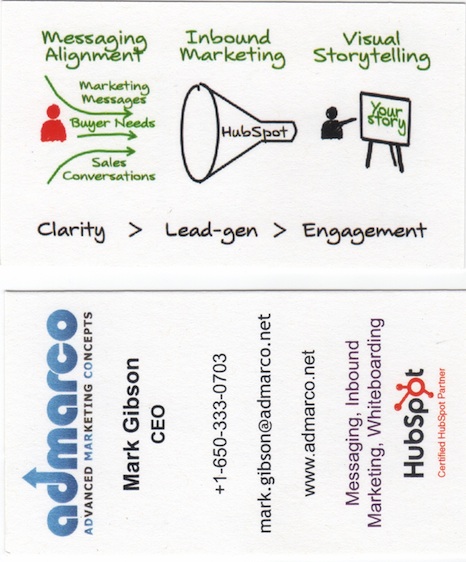Are you familiar with the Paleolithic cave paintings of Lascaux or Chauvet Caves in France? If you are not, please click on this link to the Chauvet Cave Paintings.
3 min read
Cave-Man, Selling and the Art of Visual Storytelling
By Mark Gibson on Fri, Nov 21, 2014
Topics: visual storytelling whiteboarding visual perception cave-art
2 min read
Visual Storytelling for Salespeople - Video
By Mark Gibson on Sun, Nov 02, 2014
Visual Storytelling is part 3 of the Your PowerPoint Sucks Webinar Series.
Part 1 of the series Visual Perception outlines why images are so essential to communication and for your ideas and story to be recalled.
Part 2. of the series, Basic Storytelling discusses the elements of story and how engaging emotions and adding contrast are what makes a story memorable.
Topics: visual storytelling
1 min read
Your PowerPoint Presentations Suck Pt. 1 Visual Perception -Video
By Mark Gibson on Thu, Oct 09, 2014
If they look anything like the spoof slide below, then this series of three 10-minute videos will be of interest.
PowerPoint is ubiquitous, often maligned and most often misused... but as a presentation medium it has great utility.
We just need to get better at using PowerPoint and to improve the stories and visual elements that we use to create our presentations.
Your PowerPoint Sucks and what you can do about it
Part 1. Your Powerpoint Sucks - Visual PerceptionPart 2. The Hero's Journey and basic storytelling.
Part 3. Visual storytelling for salespeople
If you or your sales enablement or marketing team needs help with the underlying messaging and storyline to bring your presentations to life, please contact us.
Topics: storytelling powerpoint visual storytelling story
3 min read
Whiteboard Selling - Book Review
By Mark Gibson on Tue, Aug 06, 2013
I Wish I Had This Book 2 Years Earlier
I wish I had this book when I started working with WhiteboardSelling in December 2010, as it would have accelerated my learning curve.I learned the craft and art of whiteboarding by observation, sitting with Corey Sommers as he went through each aspect of the Whiteboard Selling process, including:
- Kicking off the session with the client,
- Conducting the brainstorming message workshop,
- Coming up with the initial visual concepts,
- Scripting out the whiteboard story,
- Getting the whiteboard approved, and
- Training the sales teams to do the whiteboard.
The book is well-written and well worth the meager investment for anyone interested in whiteboarding.
Here's why you should buy it.
Get Clear About Your Value Proposition
In the two years with Whiteboard Selling, the typical client-messaging baseline for developing the whiteboard was 5/10 for clarity.Messaging existed in the form of PowerPoint, .pdf’s and ideas in various contributor's heads. The process of defining the whiteboard story is clearly outlined in the book and helps the whiteboard author to clarify the buyer’s issues and to focus conversation on relevant product or service capabilities using the right whiteboard structure for the buyers maturity in their buying process.... this is important!
There is a difference between a "Why Change" whiteboard story for a first call on a prospective customer and a "Why Me" whiteboard story at a closing meeting on a prospective new customer.
The differences are spelled out in the book and will help salespeople go from a 5/10 for clarity to a 9 or a 10 by the time they complete the whiteboard development process.
Whiteboard styles and design templates are included for each stage in the buying process.... these are invaluable for rookie whiteboarders.
Get Salespeople to do Product Training with a Whiteboard
Despite best efforts of product managers in sales kick-off training sessions, very little is retained from a typical PowerPoint based product training session. The only thing memorable most salespeople bring home from a typical sales kickoff event is hangover.Magic happens when you engage salespeople to do the product training using a whiteboard. The process of iterative role-playing - of presenting and watching and listening to the whiteboard development repeatedly, engages the whole brain and all of the senses.
I observed thousands of salespeople walk into training rooms having never seen the whiteboard story and doubting their ability to whiteboard. The same salespeople left four hours later capable of delivering the whiteboard the next day - they owned the message in just four hours.
Summary
- This book outlines the path to creating a sound whiteboard story that can be used to get everyone in your sales and channels team on message and to make it stick.
- Unless you happen to be a visual and cognitive genius capable of inventing images and story on the fly, don't expect some magical force to guide your pen.
- You'll never get up to the whiteboard and create something meaningful if it does not already exist in your mind.
- WhiteboardSelling methodology and process IP are now owned by Corporate Visions after they acquired the company in August 2012.
- David Jenkins and Corey Sommers have both moved on, however they have left an indelible entry in the canon of selling literature and their book Whiteboard Selling is highly recommended. You can order it here.
Topics: whiteboardselling visual storytelling whiteboarding
5 min read
Revelations on Story Telling - Survey Results
By Mark Gibson on Tue, Jun 11, 2013
Topics: mike bosworth storytelling visual storytelling
3 min read
Using Visual Storytelling to Get Your Next Job - Case Study
By Mark Gibson on Thu, May 16, 2013
Ever been laid off? I have - and chances are that at some time in your life it could happen to you. Layoff's happen, it's a fact of life in our time and it's no big deal. Companies re-organize, merge, get acquired, have a bad quarter and suddenly, headcount becomes a problem.
After 9-11, there were hundreds of thousands of sales and marketing professionals in the Bay Area suddenly unemployed. Long gone is the era of my parents (grand-parents for many readers), when you joined a company and expected to work a lifetime and retire on a pension at 65.
What happens when you do get laid off? How do you get back into the workforce and perhaps more importantly, how do you win the job you really want, when there are potentially dozens or even hundreds of others applying for the same job? Hint - be different!
Wil Loesel (www.linkedin.com/in/wloesel) worked for Time Warner Cable as a sales manager and was recently laid off due to a restructuring. Wil visited my Website earlier this month and viewed our " Your PowerPoint Presentations Suck Webinar" and decided to apply some of the ideas he learned in the Webinar to differentiate himself in his job search.
Wil's Story
"I had an interview for a B2C Manager position on May 5th. I had prepared a presentation a week earlier for another company I was interviewing at and was working on tailoring it for my interview the next day. I watched your webinar the evening prior to my interview and decided I wanted to change my entire presentation.I stayed up all night (until 8am) revising the presentation. I then slept for 2 hours, woke up and kept working, all the way until my interview. I wrote and memorized talking points and stories for each slide (keeping the slides visual, using only a word or two and a picture) and let my voice present the story."
Wil's Before Slides
There is nothing wrong with Wil's before slides, it's just that they are typical, the same meaningless graphics, too much information and have a memory retention lifecycle for the viewer of one mouse-click.This is one of the worst slides in Wil's old deck, but it's so familiar. I've seen something like this many times and when I see it my eyes glaze over it and move on. The slide below is popular at the moment. I have seen a derivative of this several times at industry conferences and Webinars already this year. It is unreadable and has too much information to be presented effectively.
Wil's After Slides
I have reduced the size of Wil's "after" slides to cover the points in his management philosophy section, because I can... you will still be able to get the key idea from each slide that Wil wanted to discuss, when the slides are shrunk. The images are clean, one main idea per slide, are easily understood and the images create meaning to support his point. It's Wil that is talking, the slides are doing their job as visual aids.
Topics: sales powerpoint visual storytelling
2 min read
Visual Confections that Sell (video)
By Mark Gibson on Wed, Jan 23, 2013
The video requires no registration form to play and runs for about 14 minutes.
It will be of interest to a broad audience who want to communicate their ideas more effectively in a shorter space of time. It will be of particular interest to those interested in leading with an opinion, supported by a visual confection, to disrupt status-quo thinking.
If you would to download the visuals and script or discuss converting your PowerPoint presentation into a visual Confection, or give feedback on the video, please complete this Let's discuss Visual Confections form.
How Visual Confections Create Value in Selling
- Visual Confections help sales people convey their value creation story, creating confidence that leads to better buyer engagement.
- Visual Confections combined with visual storytelling technique, help sales people get their big idea across more effectively in conversation.
- The process of of creating Visual Confections aligns sales and marketing messaging and brings value creation into clear focus.
- Visual confections when used in sales training can help reduce sales ramp time and foster stronger message ownership, leading to improved sales results.
Topics: sales and marketing alignment visual confections brain rules visual storytelling
2 min read
Visual Storytelling Survey Yields Startling Results
By Mark Gibson on Wed, Jan 09, 2013
The findings reveal a lack of visual storytelling techniques among marketing and sales teams, and specifically, that only 13 percent of salespeople use an interactive writing surface such as a whiteboard to support their customer conversations.
To determine what role whiteboard selling techniques play in marketing and sales teams who work in complex B2B selling environments, Corporate Visions presented questions about the use of whiteboards, how they are created, by whom and why they are used. Notable findings from the Q4 survey include:
Whiteboards are barely used
Respondents noted they use whiteboarding just 13 percent of the time to tell a visual story as part of sales conversations. The other tools mentioned most often were PowerPoint (33 percent), phone (26 percent) and in-person conversations (27 percent), which employ little to no visual components. This means salespeople are losing out on the opportunity to present ideas in a more engaging way, and to differentiate their messages, conversations and presentations to customers and prospects.Whiteboarding is not an on-purpose effort
Of those who actually report using whiteboards, 51 percent say they create them ad-hoc or borrow them from their peers. Only 24 percent are pre-built and approved as part of a strategic marketing and sales support program. For whiteboarding to be effective, marketing needs to develop the messages and tools alongside the sales team to make sure everyone is delivering a consistent, high-quality message. By pre-building whiteboards, salespeople are given the ability to deliver a simple, repeatable story with confidence and create a differentiated experience in the buying cycle.Whiteboards, when used effectively, can be leveraged in various ways –
Respondents who use whiteboards specified they are essential to the buying cycle in a number of different ways, including:- 25 percent – presenting/differentiating their solution from the competition
- 17 percent – illustrating the business impact of their solution
- 8 percent – demand generation
- 6 percent – explaining the implementation process
In fact, recent research by Aberdeen Group found that 53 percent of best-in-class companies identified creating more meaningful conversations as a top priority for increasing and sustaining revenue in an uncertain economy.
Furthermore, the firm found conducting an interactive whiteboard conversation (as opposed to a static presentation) leads to a 50 percent higher lead conversion rate, 29 percent shorter time-to-productivity and 15 percent average shorter sales cycle – helping to combat the meaningful conversation problem among businesses.
Aberdeen Group Whiteboarding Survey Dec 2012
"It's clear from the results of this survey that visual storytelling techniques like whiteboarding are alarmingly underutilized by both marketing and sales teams," said Tim Riesterer, chief strategy and marketing officer, Corporate Visions. "87 percent of today's companies are using static techniques, rather than having intimate and visually interactive conversations, which is what whiteboarding allows companies to do. Marketing and sales teams need to work together to create pre-built whiteboards that are going to differentiate themselves in the sales cycle, which in turn, will help them close more deals."
Topics: visual storytelling whiteboarding corporate visions
2 min read
Presentation Rules using Visual Storytelling to sell Big Ideas
By Mark Gibson on Thu, Jan 03, 2013
Brain Rules
I've just finished reading Brain Rules, by John Medina. It's an interesting and easy read and has a whole lot of insight on how we perceive and process information. This book could have easily been entitled "Presentation Rules" as it covers important visual perception concepts relevant for salespeople making presentations in PowerPoint.Here are few relevant points:
- The typical PowerPoint slide presentation has 42 words per slide.
- Words and orally presented information suffer in comparison to the use of images;
- If information is presented in bullet form with oral comment, typically 10% is remembered after 3 days
- Simply add a picture and recall goes to 65% - In one study, subjects were shown 2500 images for 10 seconds each and could recall 90% of them within several days and were able to remember 63% of them one year later.
- The brain is doing orders of magnitude more work to get the meaning from a sentence than a picture - words are in effect lots of small pictures that the brain needs to reconstruct and sequence to derive meaning from.
- Pictures are stored in the brain as complete entities and available for instant recall. You don't have to construct an image of a clock-face nor a light bulb in your mind to recognize it, mere mention of them conjures the image that is already stored in your brain - so use more images.
- Stories that evoke strong emotions at the time of the learning help with the encoding of that learning in memory and with the transfer of information from short-term memory to long-term memory.
- The brain/mind is easily bored.
- You have 30 seconds at the start of the presentation to hook your audience.
- A hook is a story or anecdote to engage the audience emotionally.
- If you haven't engaged them by this time, then you are sunk as they will begin to occupy their mind with other things and pay scant attention to you and your presentation.
- You should structure your presentation in 10 minute chunks, because after 10 minutes the mind begins to wander. At the end of the 10 minute chunk we need to use another hook to re-engage the audience for another 10 minutes.
Take-aways:
- If you want your big idea to be remembered, then create a simple images to convey it.
- Structure your presentation into 10 minute content chunks and tell brief stories for 30 seconds every 10 minutes to re-engage your audience.
Visual Storytelling Webinar
Relevant ideas from Brain Rules have been incorporated into a new visual storytelling webinar published in late December 2012, entitled "Your PowerPoint Presentations Suck - and what you can do about it", and I invite you to view it.This Webinar consists of the three 10 minute content chunks,
- Visual Perception
- Storytelling Basics
- An introduction to visual storytelling.
Topics: visual confections brain rules visual storytelling
5 min read
Creating Visual Storytelling Images to Empower Sales Communication
By Mark Gibson on Fri, Nov 09, 2012
If your sales letters and proposals look visually boring and are chock-full of features and benefits, and “product-speak” that’s all about you, then it's time to stop sending them and re-assess what you are trying to achieve.
Do the images you use on your Website, in your sales letter, proposals and sales conversations create clarity or confusion and cause the buyer to turn off as they try to unpack the meaning of all the chart junk, drop shadows, text boxes and block arrows?
A picture is worth a thousand words - and it truly is when it comes to communicating your ideas on your Website, in-person, over the Internet and in a sales letters and proposals.
Why?
More than 50% of the brain is dedicated to processing information in the visual field. The brain processes images differently than it processes words. Simple images are stored as complete objects, no reconstruction or thought process is required to recognize them or understand their meaning.
Collections of images tell stories in context and pre-date written language, with man’s earliest visual images painted on cave walls at Chauvet Cave in the South of France, some 45,000 years ago. These images give an inkling of the sophistication of the human brain and the power of images alone, to tell a story.
Introducing Visual Confections
According to Edward Tufte, Visual Confections are “structures that consist of a multiplicity of image events that illustrate an argument, organize information, show and enforce visual comparisons; they should be transparent, straightforward, obvious, natural, ordinary, conventional…with no need for hesitation or questioning on the part of the viewer.”When I create a whiteboard story, I am effectively creating a visual confection, consisting of hand drawn images, words and numbers that tell a story, that is ideally meaningful without any explanation.


